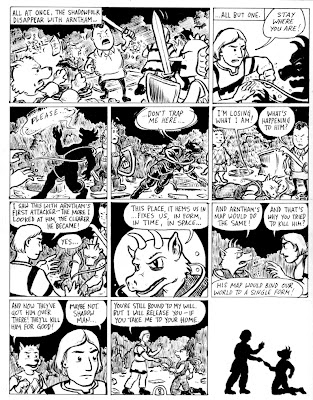
Our penultimate page. Stepan has just been transported to the shadow world by the shadow whom he bound to his will. But he had also agreed to turn the shadow loose in exchange for the journey. And so:
1) The once-kneeling shadow (Shadow 1) is now on his feet.
Shadow 1: Release me!
Caption: Do I dare?
2) The shadow has grown larger, more shapeless.
Caption: Do I have a choice?
Stepan: I'll keep my word, shadow. You're free!
3) The shadow is now huge, threatening, but Stepan is uncowed.
Stepan: Now—where's Arnthan?
Shadow 1: You don't command me now, boy—
Voice off-panel (Shadow 2): A MISTAKE!
NB: Shadow 2's panel has a distinctively wispy border throughout.
4) From far left, Shadow 1 and Stepan gaze at the ruin of the shadow world, which grows lighter and more fixed in shape as it moves to the right of the page. At the extreme right, we see Artham's once-again disembodied head on the ground. Glowing at the center of the wreckage is the map. A few pale shadow forms lie prone. Closer to Shadow 1 and Stepan is Shadow 2, a stricken look on its face.
Shadow 1: What—What's going on here?
Shadow 2: We've made a dreadful mistake!
Stepan (in the clutch of Shadow 1, looking at the disembodied head): Arntham!
5) In a wispy-bordered caption, Shadow 2 explains what happened while a borderless panel depicts what he describes. (NB: An alternative to this panel follows the script below.)
Shadow 2: We thought the danger lay in the mapmaker, so we slew him on arrival—
6)Close-up on the map, aglow and destructive, while Shadow 2's panel tails off-panel.
Shadow 2: —But the threat is in the map itself! We brought it here, and now it's petrifying everything!
7) Shadow 1, one arm still clutching Stepan, gazes determinedly at the wrack and ruin while Shadow 2 looks distraught. Stepan is tugging to remove Shadow 1's grip.
Shadow 1: Then we must destroy it!
Shadow 2: But it's deadly to our kind! You cannot go near it!
8) Stepan holds Shadow 1's arm away from him and stands freely. The shadows listen to him speak.
Stepan: But
I can. What's more, I can consume it utterly with my magic.
Shadow 2: You would do this?
9) Stepan looks at the first, threatening shadow, whose hand now rests gently on Stepan's shoulder.
Stepan: I'll save your home, and I pledge to protect it hereafter. I only ask for Arntham's head and safe conduct back to my world.
Shadow 1: I give you my word, boy.
10) Stepan, silhouetted himself by the glow of his magic, is viewed from behind as he destroys the map.
Upper caption: My magic takes the map away...
Lower caption: ...but it gives me something in return.
*******
Okay, here's the alternative for panel 5:

The text is the same. The scene sets the two shadows and Stepan in the distance looking at the reader. In the extreme right foreground: Arntham's head. Poking into the extreme left foreground: the fingers of one of Arntham's dismembered hands. Never the twain shall meet!
****
Okay, the constraints. I had to have a silhouette in every panel. With my shadowy men on their shadowy world, that's easy. I also had to use found art or found dialogue. Since I want Isaac to have a chance to use one of those
awesome Basque folklore characters on page 10, I tried to find some usable found dialogue. Folks—not easy! Either the crowds I was in were too loud actually to make out intelligible speech or what was intelligible was too contemporary and specific to be of use. (Washington politics and synagogue gossip have no place in this story!) Believe it or not, the best I could do was "What's going on here?"—genuine overheard dialogue, just not very colorful. C'est la guerre.
Finally, I had to conceal something that will be revealed by Isaac on the final page. It's good and concealed, all right, as the concealing is entirely suggested by Stepan's final caption. The constraint didn't specify a concealed
object, after all
—so Stepan is concealing some information.
Anyway, that's what I've got. Isaac: you're left with found art and a wordless sequence, and I reckon you've got to get Stepan (and Arntham's head) back home. Everybody: feedback very welcome!








































